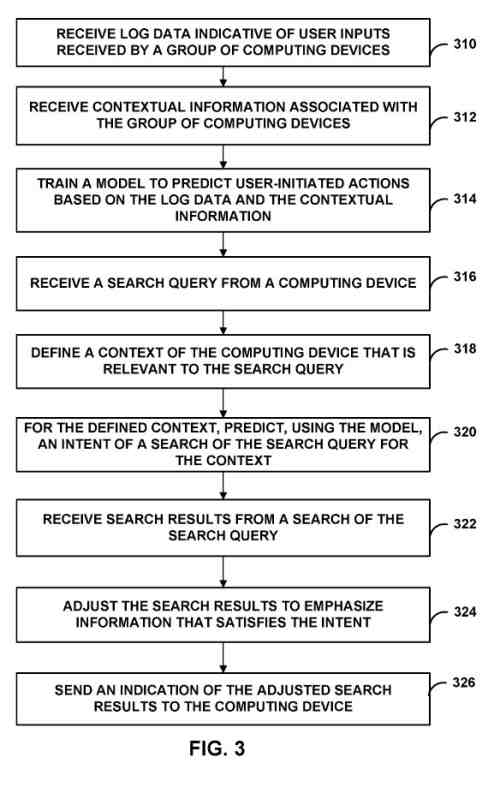I’ve been looking at sources of information that discuss the intent behind searches for many years now.I keep an eye out for patents from the search engines, and what search engineers have been saying about patents, as well.
So when a newly granted patent from Google is named “Predicting intent of a search for a particular context,” the authors of the patent have captured my attention. This is a patent granted in February of 2021.
My interest in these search intent-based patents has led me to write posts such as A Well-Formed Query Helps Search Engines Understand User Intent in the Query and Why Do People Google Google? Understanding User Data to Measure Searcher Intent.
This has also been the subject of presentations I’ve seen at search conferences, with the presenters of those sessions insisting that an SEO professional should look at the SERPs that desired keywords take them to
These speakers recommend that you look at the intent behind pages for those chosen keywords to get an idea of how other people have been optimizing pages ranking for certain keywords.
So What is This New Search Intent-based Patent About?
The Predicting intent of a search for a particular context patent begins by telling us that a searcher may use a computing device to obtain information and facts to assist the searcher in accomplishing a certain task.
To a search engine, every search begins with a searcher guessing query terms (or keywords) to use to try to find information.
This patent tells us that a searcher must provide sufficient information (e.g., search query terms) to guide a computing device to locate the information a searcher seeks.
We are cautioned that if a search query is not narrowly tailored, or if the searcher does not provide much in the way of additional information beyond the query, a computing device may return too much information.
This can mean that some of the most interesting or relevant information may be difficult for a searcher to find.
Like many patents, at the start of the description, it points out problems that a searcher may have.
These are the problems that a searcher may face when trying to find information:
The searcher may experience stress and/or waste valuable time and resources inputting very detailed queries and into a computing device, causing the computing device to execute multiple searches, or sifting through large quantities of search results, to obtain information necessary to accomplish a certain task.
Most patents provide algorithms intended to provide methods to solve problems that may be identified in the patent, and this one gets right to that point:
Techniques from this patent may help a computing system predict search intent of a query for a particular context of a computing device.
A search engine might look at contextual information to gain an idea of the intents behind a query.

The patent gives us some examples:
- Locations.
- User interest.
- Times of day.
It then tells us that the computing system may then define a relevant context for a search query and predict, based on that relevant context, intent, or the purpose of a search using the search query in the relevant context.
The patented process may then adjust the search results so that the information for satisfying the intent is emphasized over other information returned from the search.
The patent then provides examples to illustrate what they are going to try to do:
After a user of a computing device purchases tickets to a particular movie that is out in movie theatres, a user may cause the computing system to execute a search using the name of the particular movie as part of a query.
The patented system may obtain contextual information including an indication that the tickets were already purchased for a future showing of the particular movie.
In response, the system may infer (e.g., based on log data indicative of user-initiated actions performed by other computing devices) that the search including the name of the particular movie is for a purpose other than purchasing additional tickets.
The system may therefore adjust the search results returned from the search so that movie showtimes are ranked lower than other information (e.g., reviews, memorabilia, trivia, etc.) about the particular movie.
The inventors of the patent explain why they used this example of a movie to tell us about context.
They say that by automatically adjusting search results to emphasize information a searcher is more likely to be searching for, in a current context (after buying movie tickets), the system may allow searchers to experience less stress and/or not waste valuable time and resources.
Time spent hunting for the information in and amongst search results (by including the movie name in the query performed) is reduced.
The patent tells us that in using contextual information in the query to help return better results based on the intent behind the search, it will make certain not to surface results that provide personally-identifiable information.
In simple terms: Give the people what they want!
And they are serious about personal privacy, too:
For example, a user’s identity may be treated so that no personally identifiable information can be determined about the user, or a user’s geographic location may be generalized where location information is obtained (such as to a city, ZIP code, or state level) so that a particular location of a user cannot be determined.
This patent can be found at:
Predicting intent of a search for a particular context
Inventors: Yew Jin Lim, Josep Linn, Yuling Liang, Carsten Steinebach, Wei Lwun Lu, Dong Hyun Kim, James Kunz, Lauren Koepnick, and Min Yang
Assignee: Google LLC
US Patent: 10,909,124
Granted: February 2, 2021
Filed: May 18, 2017
Abstract
A computing system is described that determines, based on user-initiated actions performed by a group of computing devices, an intent of a search using a particular search query received from a computing device.
The computing system adjusts, based on the intent, at least a particular portion of search results obtained from the search using the search query by emphasizing information that satisfies the intent.
The computing system sends, to the computing device, an indication of the adjusted search results.
Predicting Intent in Searches With an Awareness of Context
Google tells us about the kinds of contextual information that might be considered when queries are performed, and that they could include information such as:
- User topics of interest (e.g., a user’s favorite “things” typically maintained as a user interest graph or some other type of data structure).
- Contact information associated with users (e.g., a user’s personal contact information as well as information about a user’s friends, co-workers, social media connections, family, etc.).
- Search histories.
- Location histories.
- Long and short-term tasks.
- Calendar information.
- Application use histories.
- Purchase histories.
- Favorites.
- Bookmarks.
- Other information that computing devices and information server systems can gather about a user of computing devices.
- Information about the operating state of a computing device.
- The physical and/or virtual environment of the user and/or the computing device at various locations and times.
How might a search engine use this context to predict a query that provides useful and helpful information to a searcher?
This is what the patent points to:
Prediction module may execute a machine-learning model (e.g., a deep-learning model) that receives as inputs: a search query (or portion of a search query) and a current context received from the context module.
The machine-learning model may generate as output, an indication (such as a label or other identifier) of an intent of a search using the search query for the current context.
The intents determined by the prediction module may be selected from a group of predefined intents.
Some examples of predefined intents include transportation or travel-related intents (e.g., ride sharing, flight status, ticket purchase, schedules, and other transportation-related intents) and entertainment-related intents (e.g., movie review, showtimes, ticket purchase, cast member biography, album or song review, artist biography, artist tour dates, and other entertainment-related intents).
Also, a score associated with intent may be decided upon.
This is what the patent tells us about that score:
The score of intent may indicate a degree of confidence (e.g., a probability or other degree of likelihood) that the purpose of executing a search using the search query in a current context is to obtain information that satisfies the intent.
Of course, we have seen language about certain thresholds being met with that score.
If the score is not high enough, the search engine may refrain from adjusting search results based on the intent.
Conversely, if it is over that threshold, the effect of intent on the query may be much stronger.
The patent provides a lot more detail on how intent might be used in connection with intent to deliver results that meet the situational and informational needs of searchers.
Expanding Intent in Search Results
When search engineers have written in the past about intent and search, they would often talk about intent in terms such as:
- Informational.
- Commercial.
- Transactional.
- Navigational.
An informational intent gets the response of a result that returned information about a query, such as the history of pizza, or a pizza recipe.
A commercial intent gets the response of a result that returned a way to purchase something related to a query, such as a local pizzeria, a store that sells pizza crust and sauce, and ovens.
A transactional intent gets the response of a result that enables a visitor to take some type of action, such as ordering a pizza for delivery to their home.
A navigational intent gets the response of a result that allows a searcher to visit a page that they may have visited before, or that they have an idea that it exists. An example of this could be a page that tells them about where Dominos Pizza was started, and who is on the board of directors for the company.
In closing, this patent looks at the context of a search and tries to guess at the intent behind that search based on that context.
This may involve a rewriting of the query to include information about that context.
More Resources:
- Google Search Patents 2020: The Mega-Post Roundup
- The Mechanics of E-A-T: How Google Patents Can Help Explain How E-A-T Works
- The Biggest SEO Trends of 2021, According to 42 Experts
Image Credit
Screenshot taken by author, March 2021





